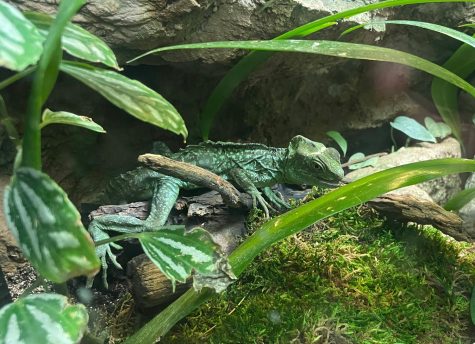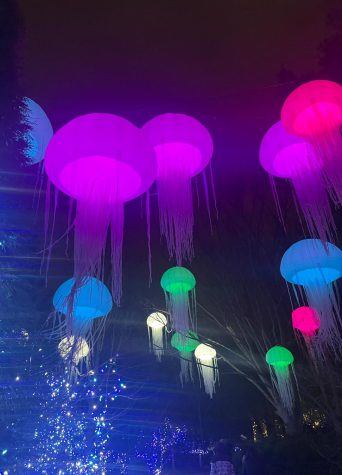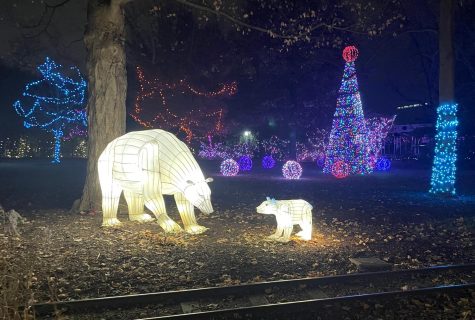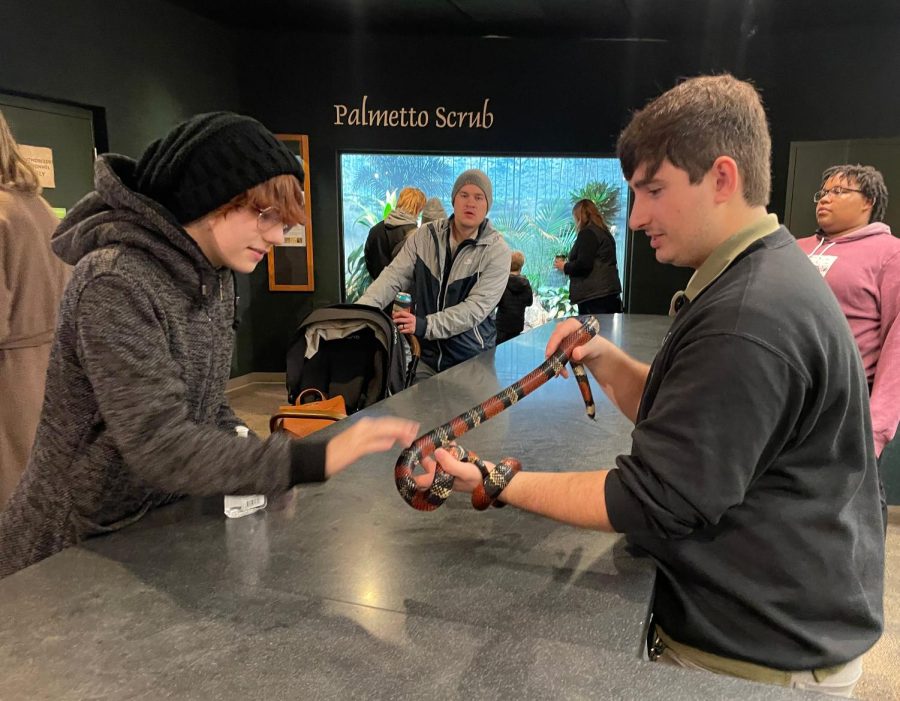Sophomore Akshaya Lingala folds a blue Post-It note into the shape of an origami blue whale. Since elementary school, Lingala said she developed a passion for whales, but the blue whale is one of over 41,000 species that are under threat of extinction, according to the International Union for Conservation of Nature (IUCN).
She said, “The first time I had ever heard of a whale was in elementary school where we had a whale unit and I learned a lot of interesting facts about the blue whale. Over the years as I learned more and more about whales, I also learned about their endangerment. It’s extremely sad to see that many whale populations are decreasing and many other animal species are also becoming extinct. People should definitely pay more attention to these species.”

(Jillian Moore)
Lingala is not the only one who wants to raise awareness of the increasing number of endangered animals. In fact, the IUCN Red List has accessed over 147,500 species and provides a series of conservation actions globally. According to the World Wide Fund for Nature (WWF), anywhere between 200 to 2,000 species go extinct every year, and the earth is losing species at a rate between 1,000 and 10,000 times higher than the natural rate.
Despite those numbers, zoology teacher Kira Hansen said many people don’t recognize the increasing number of extinct species.
“We are currently in a mass extinction caused by human actions,” Hansen said. “The causes of the increase of endangered species affect all humans because we are all living on the same planet. I do not believe most CHS staff or students are aware of the fact that many species are going extinct.”
Lingala said she agreed and said many people don’t realize the significance of these endangered species.
“Whenever I talk about whales, a lot of people take (always having these animals) for granted and (extinction) doesn’t seem like a serious issue to most people,” she said. “It sometimes bothers me how you can’t really find someone with a voice who’s willing to speak up for endangered species. I feel like many students fail to realize the significance of endangered animals and the role that they play in the environment.”

This is part of the reason the Cincinnati Zoo & Botanical Garden’s Festival of Lights event includes displays of endangered species from exotic polar bears to domestic butterflies. Zookeepers also lead “creature encounters” during the event where attendees can learn about and touch animals to provide public education. Voted Best Zoo Lights by USA Today, the annual experience started on Nov. 18 and ends on Jan. 8.
In addition, raising awareness of endangered species and their plight is also a goal of the Indianapolis Zoo. On Dec. 1, the Indianapolis Zoo announced The Campaign for Our Zoo, which will help support a number of ongoing programs and brand-new initiatives. Those include a renovated entryway and guest intake area, along with the Global Center for Species Survival, expected to open to the public on Memorial Day weekend of 2023. As a part of the campaign, the zoo is allocating $13 million for the species center, a group of local specialists collaborating globally to help prevent habitat disruption that could cause further extinction of animals and plants.
According to Julia Geschke, Indianapolis Zoo reptile and amphibian conservation coordinator, losing species negatively impacts the entire ecosystem, including humans.

“When animals are in danger of becoming extinct, it will impact the ecosystem as a whole and impact the food chains up and down and even other animals will start to be affected,” Geschke said. “This will also affect humans as some species in different parts of the world; people use them for food and that’s a critical part of their diet. Some species are used for research that helps human health, and other people just enjoy watching birds or they enjoy whale watching, so if these species go extinct these people will lose out on these opportunities and miss a piece of nature that used to be there.”
For junior Carissa Fuller, the best way to bring awareness to this issue is to educate yourself and express interest.
Fuller said, “Be mindful of your environment and work toward the habitats for these endangered animals. (It’s important to) know what animals are endangered and try not to affect their habitats. Also, expressing interest (toward the issue) hopefully can bring more people to realize just how bad the increasing amount of endangered species is. People might not be affected now, but if we don’t work to fix things now then it might be impossible later. ”
The Cincinnati Zoo & Botanical Garden, located less than two hours away from CHS, is promoting awareness of endangered species through implementation of conservation efforts and field projects. Notably, their manatee rehabilitation program rescues and treats ill orphaned, and injured manatees before releasing them back into the wild. Exposure to harmful algal bloom and watercraft propeller threats are common reasons manatees require rescue. The zoo has helped mitigate the obstacles faced by manatees and endangered species both directly and through education.

For ways to help beyond visiting zoos, Lingala said there are a variety of environmentally friendly non-profit organizations people can join.
“I think, honestly, if one student just took time to look at endangered animals, they could go on a tangent of organizations and how they could help fund research to better the lives of these animals,” she said. “There’s a lot of organizations out there that do their best to raise awareness, but, unfortunately, a lot of people tend to not look at them enough.”
Furthermore, sophomore Riley Abernathy said CHS does not clearly recognize the issue of endangered animals.
Abernathy said, “The only time I remember the issue of endangered animals appearing in school was the freshmen biology project where we made social media accounts focusing on a certain critically endangered species. I thought it was a great opportunity to learn about the different endangered animals and some of the reasons why they became endangered and how we can reverse those reasons.”
Additionally, Fuller said that endangered animals are not mentioned enough.
“We do have the butterfly garden up at the top of the trail, which is nice and points out habitat conservation, but beyond that, it is not really mentioned in school,” she said.
To promote engagement, Lingala said the school should increase signage and announcements to recognize various endangered species.

“The school, overall, should do something for the month designated to endangered animals; they could make announcements on it like how they did for cybersecurity. They should just overall, try to make an effort at what they can do to raise awareness,” Lingala said.
For its part, Geschke said the Indianapolis Zoo is increasing conservation messaging at the zoo for visitors.
“We might be having different talks or having programs for school kids that kind of build in more conservation messaging. So it’s not just facts like, ‘The kangaroo is six feet tall’ that you might talk about; it’s more like, ‘Is the kangaroo endangered or not? What role does it play in its ecosystem?’ We are just trying to spread that message in any way that we can,” she said.
Overall, Fuller said, “People seem to know that endangered species exist, but they don’t always see it and don’t always know how to help. I feel like there should be opportunities for students to learn how they can help the environment.”
If you would like to learn more about endangered animals in Indiana, click here. If you would like to learn more about endangered species globally, click here. If you would like to learn more about Indianapolis Zoo’s renovations, click here.

































![AI in films like "The Brutalist" is convenient, but shouldn’t take priority [opinion]](https://hilite.org/wp-content/uploads/2025/02/catherine-cover-1200x471.jpg)








































![Review: “The Immortal Soul Salvage Yard:” A criminally underrated poetry collection [MUSE]](https://hilite.org/wp-content/uploads/2025/03/71cju6TvqmL._AC_UF10001000_QL80_.jpg)
![Review: "Dog Man" is Unapologetically Chaotic [MUSE]](https://hilite.org/wp-content/uploads/2025/03/dogman-1200x700.jpg)
![Review: "Ne Zha 2": The WeChat family reunion I didn’t know I needed [MUSE]](https://hilite.org/wp-content/uploads/2025/03/unnamed-4.png)
![Review in Print: Maripaz Villar brings a delightfully unique style to the world of WEBTOON [MUSE]](https://hilite.org/wp-content/uploads/2023/12/maripazcover-1200x960.jpg)
![Review: “The Sword of Kaigen” is a masterpiece [MUSE]](https://hilite.org/wp-content/uploads/2023/11/Screenshot-2023-11-26-201051.png)
![Review: Gateron Oil Kings, great linear switches, okay price [MUSE]](https://hilite.org/wp-content/uploads/2023/11/Screenshot-2023-11-26-200553.png)
![Review: “A Haunting in Venice” is a significant improvement from other Agatha Christie adaptations [MUSE]](https://hilite.org/wp-content/uploads/2023/11/e7ee2938a6d422669771bce6d8088521.jpg)
![Review: A Thanksgiving story from elementary school, still just as interesting [MUSE]](https://hilite.org/wp-content/uploads/2023/11/Screenshot-2023-11-26-195514-987x1200.png)
![Review: "When I Fly Towards You", cute, uplifting youth drama [MUSE]](https://hilite.org/wp-content/uploads/2023/09/When-I-Fly-Towards-You-Chinese-drama.png)
![Postcards from Muse: Hawaii Travel Diary [MUSE]](https://hilite.org/wp-content/uploads/2023/09/My-project-1-1200x1200.jpg)
![Review: "Ladybug & Cat Noir: The Movie," departure from original show [MUSE]](https://hilite.org/wp-content/uploads/2023/09/Ladybug__Cat_Noir_-_The_Movie_poster.jpg)
![Review in Print: "Hidden Love" is the cute, uplifting drama everyone needs [MUSE]](https://hilite.org/wp-content/uploads/2023/09/hiddenlovecover-e1693597208225-1030x1200.png)
![Review in Print: "Heartstopper" is the heartwarming queer romance we all need [MUSE]](https://hilite.org/wp-content/uploads/2023/08/museheartstoppercover-1200x654.png)



